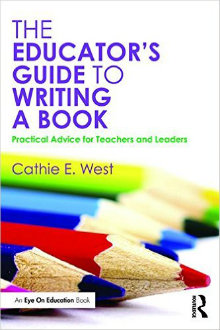Learn How to Write an Education Book
The Educator’s Guide to Writing a Book: Practical Advice for Teachers and Leaders
By Cathie E. West
(Routledge/Eye on Education, 2016 – Learn more)

Who knew this slim, 140-page book would read more like a summer beach thriller than a didactic, pedantic education tome? With a title like The Educator’s Guide to Writing a Book, I thought the content would be interesting but dry, useful but not necessarily entertaining. However, once I started reading, I couldn’t put it down.

But after reading The Educator’s Guide to Writing a Book, I feel well equipped to do just that. Cathie West takes readers through all the steps of getting a book published: from developing an idea to marketing the finished product. The comprehensive information in this book will give you the confidence to take that idea you have and see it through to completion.
Why write?
The first chapter is called “Why Write?” and it hooked me on the second page by describing various reasons people write education books…and reasons why they shouldn’t. It then describes characteristics of successful authors and reminds educators that they already possess them: confidence, commitment, conscientiousness, and courage.
Other sections of the chapter include a discussion of goals for writing, how to create an optimum environment for writing, and an interview with a teacher who is in the process of writing a book. The chapter ends, as all the chapters in this book do, with “Take-Away Tips,” “Reflections—Connections,” “Best Practice” ideas, and a list of references.
The second chapter is about the different types of education books and what readers want from such books. A very helpful table on page 24 lists eight features of what West calls a “best-practice book” and describes each of them, cross-referencing each feature with the chapter in this book that discusses them in greater detail. Since every chapter includes an interview, in Chapter 2 the author talks with an administrator about what makes a book a must-read.
From Prospectus to Publication
The remaining chapters in The Educator’s Guide to Writing a Book cover the process involved in getting a book published. Chapter 3: Book Mechanics and Safeguards, was fascinating. The terms “front matter” and “back matter” are defined, and all the parts of a book are explained. Publishers’ guidelines are also addressed. Chapter 4: Titles, Topics, and Themes, is all about how to find the central idea for your book and how to write a book proposal for a publisher which, I discovered, is called a “prospectus” in the publishing industry.
In Chapter 5: Writing Style and Steps, the importance of finding your own writing style is discussed and tips for writing are provided. West herself writes in an engaging style that is clear and enjoyable to read. This chapter also includes the steps an author goes through when writing a book and the steps a book goes through as it is being readied for publication.
The roles and responsibilities of various people from the publishing company are described in Chapter 6: Publishing People and Processes. Information about contracts is also included. Chapter 7 is the conclusion and reiterates why educators can be successful authors.
Beyond the Text: Plentiful Appendices
Ten appendices offer readers worksheets to help them develop their ideas and writing schedules along with examples of a query letter, a prospectus, and a submission letter. The sample prospectus is for this very book, which is an inspired idea and very useful as readers can see how it was pitched to a publisher. All ten of these appendix resources are helpfully available as free downloads by accessing a URL provided at the beginning of the book.
In addition to the interviews, which also showcase a copy editor, an editor, a principal, and an associate marketing manager and consequently give readers insight into various aspects of the book publishing process, West includes excerpts from email exchanges she had with people from her publishing company to illustrate the points she makes. These are very helpful, too, as are the little tips presented in boxes that are scattered throughout the book.
The only quibble I have, and it is a very small one, is about the design of the boxes that surround the interviews and the three sections at the end of each chapter. The boxes are not enclosed on all four sides, and at first it was a little confusing because I thought the information continued on a following page. Once I realized it didn’t and that was the style for those sections, I got used to it.
The Educator’s Guide to Writing a Book makes the whole process of writing a book much less daunting, much more doable, and much less mysterious. As West writes on page 97, “The level of excitement that comes from signing a contract for a book will be exceeded only when you see your name on the front cover.”
This is an essential resource for any educator who has ever dreamed of seeing their name on the cover of a book they wrote themselves.
________________
Susan Schwartz taught EFL/ESL at universities in Asia and a public school in Massachusetts for 25 years and now creates digital education resources. She has written for TESOL International Administration’s New Ways series of books, English Teaching Forum, The Journal of the Imagination in Language Learning, and Pelangi: An Education Magazine about Indonesia, among other journals. Someday, she hopes to publish a book combining her interests in ESL, travel photography and social studies.































Susan:
Your affirmative and well developed critique of The Educator’s Guide to Writing a Book is much appreciated. Every educator has stories to tell that will help others—teachers, school level leaders, and district administrators—perfect their performances. I hope that my book helps educators share their hard-won wisdom and experiences. — Cathie E. West, Author
I’m a true fan of great writing, however, I would like to know more about writing an educational book for a large university class etc. Thanks.